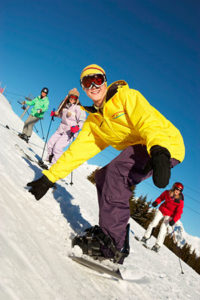Common Skiing and Snowboarding Injuries
 The skiing versus snowboarding split is mostly a cultural one. Both are great core workouts that depend on speed, strength, balance and flexibility. Evidence suggests that skiers and boarders use their bodies differently, as shown by the varying injuries they receive. Common snowboard injuries are wrist, shoulder and ankle-specific, while skiers commonly sustain knee ligament injuries. But these aren’t the only injuries sustained.
The skiing versus snowboarding split is mostly a cultural one. Both are great core workouts that depend on speed, strength, balance and flexibility. Evidence suggests that skiers and boarders use their bodies differently, as shown by the varying injuries they receive. Common snowboard injuries are wrist, shoulder and ankle-specific, while skiers commonly sustain knee ligament injuries. But these aren’t the only injuries sustained.
Skiing and snowboarding injuries involve many different areas of the body, but they have slightly different injury patterns. The movement in both sports is fundamentally different, which tends to result in different falls and injuries.
Over 75% of ski injuries result in a fracture or sprain, mainly in the lower limb, most commonly the knee. Releasable bindings have led to a decrease in leg fractures, but knee sprains are on the rise.
Skiing Injuries
Skiers are more likely to suffer knee injuries (the most prevalent injury accounts for 1/3 of all ski-related injuries) from the torque-type falls, which often result in tears to the ACL (anterior cruciate ligament) or MCL (medial collateral ligament), thumb injuries (related to ligaments torn at the base of the thumb caused by sudden hyperextension) and head injuries or trauma (caused by falls, accidents and high-speed impact with objects or surfaces). The best prevention for head injuries is wearing a helmet, although some statistics show that they are still only worn by roughly 80% of skiers. That is according to the Canadian Ski Council.
Snowboarding Injuries
Snowboarders have both feet strapped onto the board and pointing in the same direction, which usually protects the knee from twisting (the skier’s fate), although it does occasionally happen. Boarders usually land on their hands, shoulders, head or rear when they fall. The most typical of all boarding injuries is a wrist fracture (caused by loss of balance and instinctively outstretching a hand to break the fall). They also suffer from ankle injuries (caused by hard sideways impact, most common after jumping), contusions and shoulder rotator cuff injuries (affecting the four muscles and tendons that keep the shoulder in place). Collarbones, concussions (from a fall or direct blow to the head) and neck and head injuries are also extremely worrisome. Head injuries are serious and are usually the result of crashes or impact with natural objects (hard snow, rocks and trees) and unnatural objects (such as rails and boxes in some snow parks). Spinal cord injuries can result from a fall or trauma to the spinal cord, and severity ranges from loss of function in a limb to paralysis.
Prevention is the best defence. Getting in the habit of safely falling is helpful in preventing injury. Keep your arms tucked into your sides with fists closed to reduce the risk of shoulder injuries and dislocation. Absorbing the fall on your forearms will distribute the force. Don’t try and sit down mid-fall. If you jump, don’t land on straightened knees. Try bending them to help absorb the force to prevent severe strain on your joints. Always know your surroundings and stay on a slope suited for your skill level.
If you sustain a sprain or strain related to skiing or snowboarding and would like to be evaluated, call our office to schedule an evaluation. We can assess, treat and rehabilitate your injury. The correct treatment for an acute injury will help minimize your recovery time. Do not ignore the injury.








